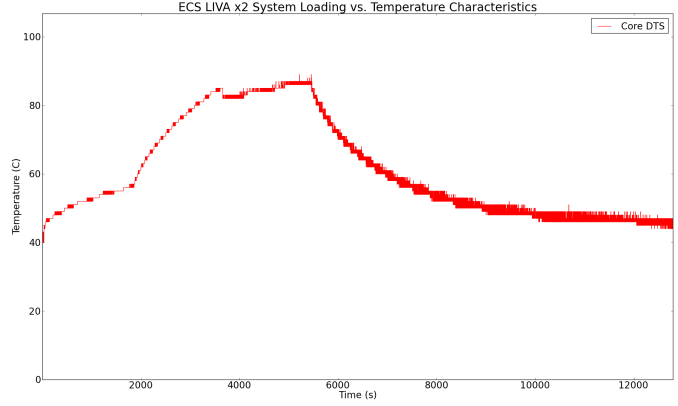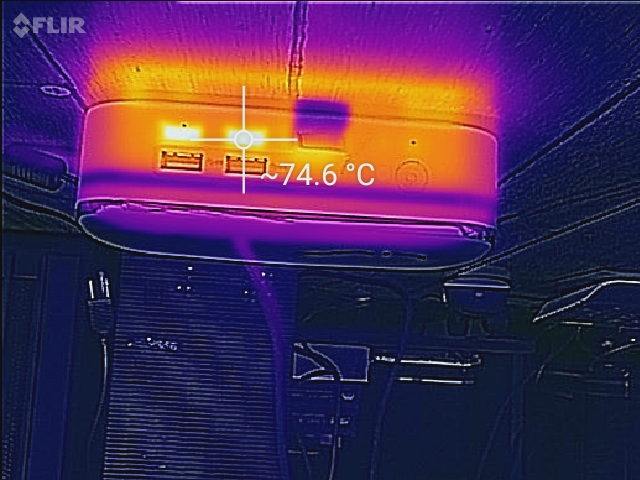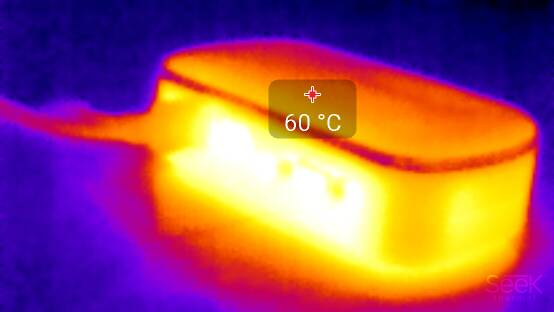ECS LIVA x2 Review: A Compact & Fanless Braswell PC
by Ganesh T S on August 24, 2015 8:00 AM ESTPower Consumption and Thermal Performance
The power consumption at the wall was measured with a 1080p display being driven through the HDMI port. In the graphs below, we compare the idle and load power of the ECS LIVA x2 with other low power PCs evaluated before. For load power consumption, we ran Furmark 1.12.0 and Prime95 v27.9 together. As mentioned earlier, the ECS LIVA machines continue to be amongst the most power-efficient systems that we have evaluated.


The idle power is the lowest we have seen, with LPDDR3 the single channel DDR3L memory and eMMC storage contributing in a major manner to bring the value down. With respect to load power consumption, the higher clocks in the Celeron N3050 (compared to the Celeron N3000) make it consume more power at the wall compared to the ASRock Beebox.
Compared to the ASRock Beebox, the thermal design for the Intel Celeron N3050 in the ECS LIVA x2 is much more challenging. Both SoCs have the same 2C/2T configuration, but the N3050 can sustain much higher clocks thanks to its 6W TDP. The Celeron N3000 in the Beebox has a 4W TDP. Opening up the screws of the underside of the chassis reveals a substantially heavy metal heat sink with a couple of copper heat pipes.
Even though the sides and the bottom of the chassis are perforated to allow for convective cooling, it seems a little odd that there is no outlet for heat to escape from the top. In order to evaluate the efficiency of this thermal solution, we starting the system at idle, followed by 30 minutes of pure CPU loading. This is followed by another 30 minutes of both CPU and GPU being loaded simultaneously. After this, the CPU load was removed, allowing the GPU to be loaded alone for another 30 minutes.The various clocks in the system as well as the temperatures within the unit are presented below.
The CPU clocks stay at 2.16 GHz throughout the portion when the CPU is under load. With the load removed, the clocks go down to 480 MHz. The GPU clocks, on the other hand, show some strange behavior compared to the ASRock Beebox. The clocks stay close to 600 MHz most of the time. In any case, it can be said that all these frequencies are managed to ensure that the TDP limits are obeyed. Sustained operation at the maximum turbo frequency for pure CPU loading indicates that the system's thermal design doesn't hobble the performance of the unit in any way. Moving on to the temperatures during the process, we find that the SoC reaches 87 C, dangerously close to the 90 C maximum junction temperature. We also find that the temperature increase rate is considerably more when the GPU starts getting loaded. After 80 C, the thermal design seems to try valiantly to keep the temperature below 90 C. While we didn't have any issue in our test environment (with an ambient temperature of 26 C), hotter ambient temperatures could cause problems in this artificial power virus test.
The absence of any perforations for convetive cooling on the top of the chassis also manifests itself in the long tail for the temperature drop off seen in the above graph. The idling temperature seems to get reached only after more than 2 hours of no load in the system.
Another important aspect to keep note of while evaluating fanless PCs is the chassis temperature. Using FLIR's FLIR One for Android thermal imager, we observed the chassis temperature after the CPU package temperature reached the steady state value in the above graph (close to the end of our thermal stress routine). I should stress here that the FLIR One has some teething troubles with certain Android devices, and I could only use the HTC One M7 for this. Unfortunately, the FLIR One for Android suffers from the same orientation problem as the Seek Thermal, and the thermal photograph could only be taken upside down.
We have some more thermal photographs in the gallery below.
Even though this is a power virus test, the chassis temperatures reach an uncomfortable 75 C. ECS has taken the unenviable task of providing passive cooling for a 6W TDP SoC in a plastic chassis, and the problems are evident. It is likely that a chassis design similar to that of the Zotac C-series nano units (with perforations all around) could help with this aspect.
For the sake of completeness, we also have a shot from the Seek Thermal thermal imager that we have used in all our passively cooled PC reviews so far.
It should be noted that the Seek Thermal indicates a chassis temperature of 60 C only, though much hotter parts are visible in the thermal profile picture above. Recent updates to the Seek Thermal app have resulted in this problem, prompting our shift to the FLIR One for Android for this purpose.





















30 Comments
View All Comments
BrokenCrayons - Tuesday, August 25, 2015 - link
Hi BMN! Not everyone out there is concerned with video playback for a system like this. As a small/cheap/quiet word processor and e-mail fetcher, platforms like the Liva x2 are perfectly suitable. Also, many people don't really worry much over specific decoding capabilities. As long as their new little computer can stream YouTube, Netflix, and Hulu, there's nothing to worry about and digging into the specifics isn't important or relevant.kmmatney - Monday, August 24, 2015 - link
I have a baytrail 3735D (quad core), which benchmarks about the same as the Braswell N3050, and while it seems fast enough most of the time, there are way to many instances where it skips and lags. Maybe it has to do with the eMMC storage, the overall experience isn't great. It's fine for a little while, but open up a few web pages, and things suddenly slow way down (with 2GB of RAM).BillyONeal - Monday, August 24, 2015 - link
Perhaps you meant envelope ?
experttech - Monday, August 24, 2015 - link
I just built a ASROCK N3150 B based HTPC and am quite impressed with the performance. The quad core chip comes for the same price as the N3050 and is quite impressive at I think it was like 6 watts of power. First time using a fanless CPU it feels awesome and weird when you turn on the system. You don't really feel its turned on! Perfect for watching all kinds of movies!BMNify - Monday, August 24, 2015 - link
you are far better off buying any Amlogic S812 or related HTPC box with http://www.cnx-software.com/ that comes with HDMI2 at 60fps HW/SW playback NEON 128-bit SIMD (and encode if its activated) as a generic option than even the very latest Atom x5 x5-Z8300 that yet again removes AVX/2 SIMD and is by all accounts not even as good as the antiquated Atom-Z3735F Q1'14 http://cpuboss.com/cpus/Intel-Atom-x5-x5-Z8300-vs-..."Instruction set extensions
SSE2
SSE4
SSE3
EM64T
SSE
SSE4.1
SSE4.2
Supplemental SSE3
AES
Supports dynamic frequency scaling N
owarchild - Monday, August 24, 2015 - link
BMNify, I'm not aware of any Amlogic S812 box with HDMI 2.0, can you give an example? CPU wise, Braswell is more powerful than Amlogic S812, for example a N3150 can decode H264 Hi10p. It's a pitty that Anandtech doesn't test the Braswell boxes with the latest OpenELEC beta versions...BMNify - Monday, August 24, 2015 - link
see http://kodi.wiki/view/Android_hardware for list to start with several Rockchip ,Amlogic, and x1 devices are capable, you need to review them and choose your requirementssearch "Amlogic HDMI 2" etc and try here for a device that suits you http://www.geekbuying.com/Search/?keyword=RK3288
emblemparade - Monday, August 24, 2015 - link
I have the original LIVA, which has a N2807, and costs about the same as this new one. I love it!The only reason to "upgrade" would be for the better GPU and slightly better wifi. The CPUs, in fact, are equal in ability: http://www.cpubenchmark.net/compare.php?cmp[]=2263&cmp[]=2541
But actually, the X2 seems like a worse machine. It's bigger and sips more power. If you're interested in this box, consider getting the original model if you can find it!
ZachSaw - Monday, August 24, 2015 - link
For so many years Anandtech's HTPC reviews have been spreading misconceptions about the 23.976Hz refresh rate. As an avid reader, I used to think getting the perfect 23.976Hz refresh rate is all you need and have spent countless hours trying to do that with the various HTPCs I've owned over the years.As you used madVR to test HTPC "credentials", it unfortunately lacks an important metric in its debug OSD -- the actual frame rate the video is being played back. This takes the reference clock into account - so even if the display refresh rate says 23.976Hz (which in this case isn't even close - it's only 23.974Hz), you still have to multiply that by refclk (-ve makes it even lower). As you could see in your own screenshot, you still get a frame drop every half an hour. The unfortunate thing about this is, every ECS LIVA x2 box is going to have a slightly different rate.
And let's not forget that not all sources are 23.976fps - some are true 24p video, others are 60p etc. Some monitors still don't report 60Hz in its EDID!
To get true frame drop-/repeat-free playback, your media player needs to have the ability to do something like Reclock. Most of you probably haven't noticed but the DirectSound Audio Renderer (or any non-exclusive audio renderers) already resamples your audio before it goes out to your audio card (the only case where it doesn't resample is when your audio stream is the exact match of your Windows global audio settings and nothing else is playing audio). As such, asking the audio renderer to resample the audio a bit to make it match the display refresh rates won't affect the audio quality much but it will get rid of frame repeats / drops completely. If you care about audio quality, the Sanear Audio Renderer in Wasapi mode is the preferred choice. Anything less than 3% in clock adjustments will yield max audio quality. So even if you have a 24Hz refresh rate, adjusting 23.976fps to play at 24fps won't affect audio quality.
MPDN has an open source implementation of Reclock (to be used with either DirectSound or Sanear Audio Renderer) - https://github.com/zachsaw/MPDN_Extensions/blob/ma...
Oxford Guy - Tuesday, August 25, 2015 - link
Why not run the thermal test with the top of the unit off?